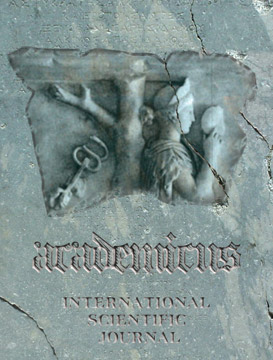Title:
The Digital as Sacred Space: Exploring the Online Religious Dimension.
Full Reference List:
| 1. | Axner, M. (2015). Studying Public Religions: Visibility, Authority and the Public/Private Distinction. In T. Hjelm (Ed.), *Is God Back? Reconsidering the New Visibility of ReligionNew York: Bloomsbury Publishing. |
| 2. | Battista, D. (2023). For better or for worse: politics marries pop culture (TikTok and the 2022 Italian elections). Society Register, 7(1), 117-142. |
| 3. | Battista, D., & Uva, G. (2023). Exploring the Legal Regulation of Social Media in Europe: A Review of Dynamics and Challenges—Current Trends and Future Developments. Sustainability, 15(5), 4144. |
| 4. | Berzano, L. (2011). Religious lifestyles. In Religion, Spirituality and Everyday Practice (pp. 57-73). Dordrecht: Springer Netherlands. |
| 5. | Berger, P. L., & Luckmann, T. (1967). Aspects sociologiques du pluralisme. Archives de sociologie des religions, 117-127. |
| 6. | Berger, P. L. (2012). Further thoughts on religion and modernity. Society, 49(4), 313-316. |
| 7. | Berger, P. L. (2017). The desecularization of the world: A global overview. In The New Sociology of Knowledge (pp. 61-76). |
| 8. | Bryant, J. M. (2010). The Sociology of Early Christianity: From History to Theory, and Back Again. In B. S. Turner (Ed.), The New Blackwell Companion to the Sociology of Religion (pp. 309-339). Chichester: Blackwell Publishing. |
| 9. | Casanova, J. (1994). Public Religions in the Modern World. Chicago: University Press. |
| 10. | Cerioli, P. J. (2021). “Mediatic Globalization” e propaganda religiosa nella società iperreale. Quaderni di diritto e politica ecclesiastica, 24(1), 119-129. |
| 11. | Cesari, J. (2004). Islam in the West: Globalization and the Muslim World. Culture, Religion, and Modernity, 87-90. |
| 12. | Chadwick, A. (2013). The Hybrid Media System: Politics and Power. Oxford University Press. |
| 13. | Evolvi, G. (2019). Blogging my Religion: Secular, Muslim, and Catholic Media Spaces in Europe. London: Routledge. |
| 14. | Ferrarotti, F. (2018). Sacred and Profane. Essential ambiguity and vital necessity of the Sacred. Academicus International Scientific Journal, 17, 09-35. https://doi.org/10.7336/academicus.2018.17.01 |
| 15. | García-Peñalvo, F. J. (2016). La socialización como proceso clave en la gestión del conocimiento. Education in the Knowledge Society, 17*(2), 7-14. https://doi.org/10.14201/eks2016172714 |
| 16. | Knott, K., Poole, E., & Taira, T. (2013). *Media Portrayals of Religion and the Secular Sacred: Representation and Change. London: Routledge. |
| 17. | Hjarvard, S. (2008). The mediatization of society. Nordicom Review, 29(2), 102-131. |
| 18. | Hjarvard, S. (2011). The Mediatisation of Religion: Theorising Religion, Media and Social Change. Culture and Religion, 12 (2), 119-135. |
| 19. | Hjarvard, S. (2012). Three forms of mediatized religion. Mediatization and religion: Nordic perspectives, 21-44. |
| 20. | Hjelm, T. (2015). Is God Back? Reconsidering the New Visibility of Religion. New York: Bloomsbury Publishing. |
| 21. | Joas, H. (2015). Do We Need Religion? On the Experience of Self-Transcendence. London: Routledge. |
| 22. | Isetti, G., Stawinoga, A., & Pechlaner, H. (2021). Pastoral care at the time of lockdown - An exploratory study of the Catholic Church in South Tyrol (Italy). Journal of Religion, Media and Digital Culture, 10 (3), 355-381. |
| 23. | Leone, M. (2014). Spiritualità digitale: il senso religioso nell’era della smaterializzazione. Spiritualità digitale, 1-55. |
| 24. | Lipovetsky, G. (2019). *Piacere e colpire: La società della seduzione. Milano: Raffaello Cortina Editore. |
| 25. | Lövheim, M., & Lindermann, A. (2015). Media, Religion and Modernity: Editorials and Religion in Swedish Daily Press. In T. Hjelm (Ed.), Is God Back? Reconsidering the New Visibility of Religion. London-New York: Bloomsbury. |
| 26. | Lundby, K. (2009). Mediatization: Concept, Changes, Consequences. New York: Peter Lang. |
| 27. | Macioti, Maria Immacolata. and Musaraj, Arta. “Albania and the teaching of religion in schools.” Academicus International Scientific Journal, vol. 15, 2017, pp. 14-27., https://doi.org/10.7336/academicus.2017.15.01. |
| 28. | Marchetti, R. (2015). La Chiesa in internet. La sfida dei media digitali. Roma: Carocci. |
| 29. | McLuhan, M. (1964). Understanding Media: The Extensions of Man. London: Routledge Classics. |
| 30. | Pond, A., Smith, G., & Clement, S. (2010). “Religion Among the Millennials.” Pew Research Center, Washington, D.C. |
| 31. | Pratiwi, P. S., Seytawati, M. P., Hidayatullah, A. F., & Ismail, I. (2021). Moderasi Beragama dan Media Sosial (Studi Analisis Konten Instagram & Tik-Tok). Jurnal Dakwah dan Komunikasi, 6 (1), 83-94. |
| 32. | Scott, W. R. (2013). Institutions and Organizations: Ideas, Interests, and Identities. Los Angeles: Sage. |
| 33. | Grossi, G. (2011). Sfera pubblica e flussi di comunicazione nell’epoca della rete. In L. Mosca & C. Vaccari (Eds.), Nuovi media, nuova politica? Partecipazione e mobilitazione online da MoveOn al Movimento 5 Stelle (pp. 35-62). Milano: FrancoAngeli. |
| 34. | Riva, G. (2016). I social network. Bologna: Il Mulino. |
| 35. | Resina, J. (2010). Ciberpolítica, redes sociales y nuevas movilizaciones en España: el impacto digital en los procesos de deliberación y participación ciudadana. *Mediaciones Sociales, 7*(2), 143-164. http://bit.ly/2LZ8f0n |
| 36. | Salmon, C. (2013). Storytelling: la machine à fabriquer des histoires et à formater les esprits. Paris: La Découverte. |
| 37. | Tentori, T. (1986). L’informazione religiosa nella stampa italiana. Milano: Franco Angeli. |
| 38. | Vecoli, F. (2013). La religione ai tempi del web. Roma-Bari: Laterza. |
| 39. | Vesnic-Alujevic, L. (2012). Political participation and web 2.0 in Europe: A case study of Facebook. Public Relations Review, 38 (3), 466-470. doi: 10.1016/j.pubrev.2012.01.010 |
Back to article
Academicus
International Scientific Journal
pISSN 2079-3715
eISSN 2309-1088
Address:
Sheshi i Flamurit, Rruga Muze
Al-9401 Vlorë, Albania
Tel: +355 68 60 60 555
info@academicus.edu.al
https://academicus.edu.al


